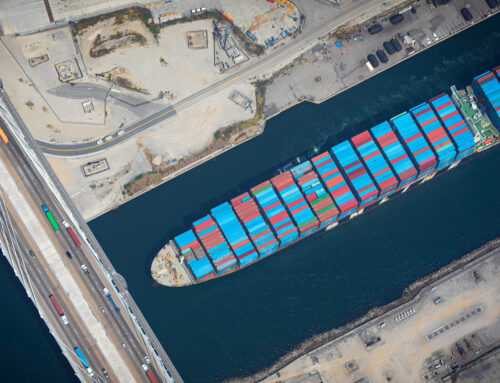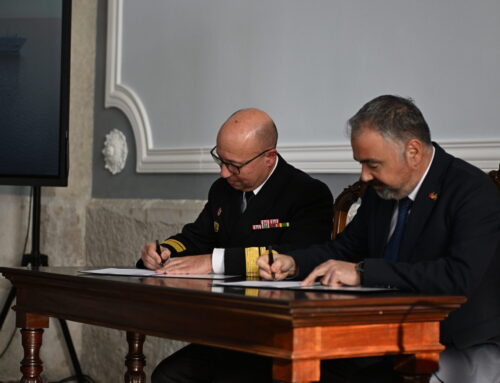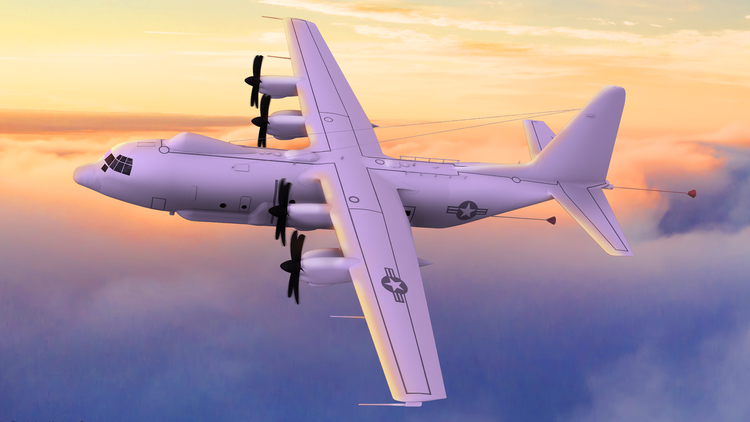
Red Cat’s Edge 130 vertical takeoff and landing drone is a Blue UAS approved military-grade system for longer-range high-endurance intelligence, surveillance, and reconnaissance. (Red Cat photo)
Red Cat’s new family of systems includes a common ground control system for three aircraft: the American-made Teal 2 quadcopter and the Edge 130 Blue, a VTOL fixed-wing system – both of which are on the Defense Innovation Unit’s Blue List – and a new FANG line of first-person view (FPV) drones of different sizes and capabilities. We discuss the asymmetric advantage of these systems with Red Cat Founder and CTO George Matus.
Breaking Defense: Tell us about Red Cat and its two main subsidiaries: Teal Drones and FlightWave.

Red Cat Founder and CTO George Matus.
George Matus: Red Cat is a drone technology company founded by our CEO Jeff Thompson in 2018. We develop robotic hardware and software primarily for U.S. government and NATO allies. Our mission is to provide critical situational awareness and enhance the effectiveness and safety of military and security operations around the world. Red Cat provides American-made technology products to the drone industry through its two wholly owned subsidiaries: Teal Drones and FlightWave.
Red Cat acquired Teal in September 2021. Teal is a Salt Lake City-based drone company that I founded in 2015. Post acquisition, Teal started to evolve from our roots in consumer drones to address the needs of public safety and national security use cases. Our company built the first mass produced drone built entirely in the U.S., with Department of Defense compliant components, and today has a factory staffed with over 100 employees.
In the summer of 2024, Red Cat acquired FlightWave Aerospace Systems. This was a strategic move to build out a family of small unmanned systems. FlightWave is an industry leader in Vertical Take-off and Landing (VTOL) drone, sensor and software solutions.
This acquisition brought the Edge 130, a Blue UAS approved military-grade system into Red Cat’s product line. The strategy was to expand Teal’s capabilities with extended range and endurance, additional payloads, and broader use in maritime environments.
What’s the significance of being on the Blue List?
Teal was one of the first Blue UAS-approved companies going as far back as 2020. The Blue UAS effort was started by the Defense Innovation Unit (DIU) to establish a trusted supply of drones to the U.S. Government. This stamp of approval means being compliant in both supply chain and cyber security, and follows a regimented process to ensure a company and its products meet all of the associated requirements.
Teal was the first U.S. company to ever mass produce this category of drone in America and was prepared to be part of Blue UAS as soon as the program was created.
What’s driving the requirements for quadcopters? What are the missions and payloads they’re most suited for?
Quadcopters are being used for many different use cases across enterprise, public safety, and defense. Teal’s products are dual-use such that they can be deployed across each of these verticals.
Specific to defense, we’re now seeing that drones are currently the most impactful technology in war. When we consider what to design and build, we essentially combine three methods: first we listen carefully to end-users and their feedback, we design toward official requirements provided by our government customers, and third we use our experience to fill in any gaps we see to make the best product possible and delight our users.
Our drones are fully modular, interoperable, and designed to be similar to smartphones, where they have powerful compute and sensors onboard that allow advanced software and applications to run on top of that. Our flagship product right now is the Teal 2 which is being deployed across the country and with allied countries around the world.
For our new line of FPV drones, the most appropriate missions are short-range, any environment ISR (intelligence, surveillance, and reconnaissance) with the option for delivery of kinetic effects.
Now with Red Cat’s acquisition of FlightWave, we’re introducing a fixed-wing VTOL system into our product line. The Edge 130 is a longer-range high-endurance ISR aircraft and rounds out our family of systems. This is the world’s most affordable and first backpackable family of systems.

Red Cat’s Teal 2 quadcopter is an American made drone weighing under three pounds, and features a high-resolution dual EO/IR sensor, modular architecture, powerful onboard compute, and a variety of software integrations for autonomy and AI. (Red Cat photo)
Describe this new family of systems that Red Cat announced at Eurosatory.
In the context of defense, there is a paradigm shift underway on the architecture of battlefields. Increasingly, the U.S Department of Defense and ministries of defense globally are moving away from conventional platforms that are large and extremely expensive, and are beginning to adopt small, low-cost products that provide true asymmetric advantages.
Red Cat is at the forefront of this sea change. Our goal is to give warfighters the tools they need to be successful on the modern battlefield. That was the genesis of the Red Cat Family of Systems. What we announced at Eurosatory includes three aircraft with complementary capabilities and a common Ground Control System (GCS).
The core of the family is the Teal 2 quadcopter. It is an American made drone that’s designed to “Dominate the Night”. Weighing under three pounds, it features a high-resolution dual EO/IR sensor, modular architecture, powerful onboard compute, and a wide variety of software integrations for autonomy and AI. It’s ruggedized to be used in any environment and harsh weather conditions, while also offering field repairability on all subsystems.
The next entrant into the family of systems is the Edge 130 Blue, a VTOL fixed wing system that can be assembled and launched in just one minute by a single user to capture and stream high-resolution aerial imagery with long-range capability. Still weighing under four pounds and being backpackable, the Edge 130 can fly for over 2 hours, an industry-leading endurance among all Blue UAS approved drones today.
Rounding out the Family of Systems is a new FANG line of first-person view (FPV) drones of different sizes and capabilities. The first in the line of FPV drones provides precision strike capabilities and gives warfighters the option to combine the ISR capabilities of the rest of the family.
What is Red Cat’s ability to manufacture at scale?
Our factory in Salt Lake City houses both our R&D team and manufacturing team. We’ve designed our products and infrastructure to scale with demand into the thousands of drones per month. Our vetted supply chain vendors enable the company to source the components needed to build these drones at those large volumes. Having R&D integrated very deeply enables for agile development and innovation. Our factory, with its state of the art tools and processes, combined with our world class team, is helping America to rebuild its drone industrial base which we believe is vital to our national security.
Tell us about Partners and the consortium.
We believe that no single company can protect this country alone. A few months ago we announced the Red Cat Futures Initiative to solve this problem. The RFI is a robotics and autonomous systems consortium designed to bridge critical UAS technology gaps for warfighters. It is an independent, industry-wide community of partners dedicated to putting the most advanced and interoperable uncrewed aircraft systems into the hands of warfighters.
As a leader in the drone industry, we developed and launched this initiative to support the Pentagon’s desire to accelerate innovation for its Replicator Initiative and the need for low-cost, autonomous systems across air, land, sea, and subsea environments.
The consortium will collaborate to ensure requirements based UAS production that meets the needs of specific missions, as well as reduce vendor lock-in and promote innovation and interoperability. The RFI will also engage in R&D and government advocacy that accelerates technology maturation. The RFI brings together the most innovative UAS hardware and software companies focused on AIU/ML, swarming, FPV, command and control, charging/power, payloads and others based on the needs of warfighters.
At launch in May 2024, the founding partners included Ocean Power Technologies, Sentien Robotics, Primordial Labs, Athena AI, Unusual Machines, Reach Power, and MMS Products. The shared goal of RFI is advocacy, integrations, and co-marketing that bridges considerable tech gaps in the UAS industry through modular open architecture. I am very excited to be partnering with so many amazing companies.










